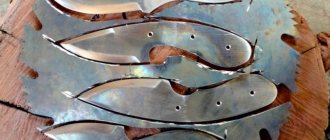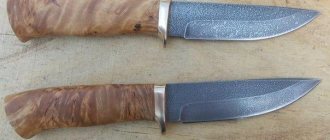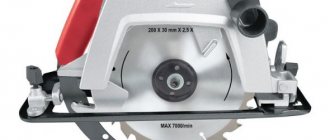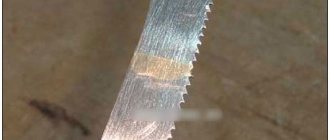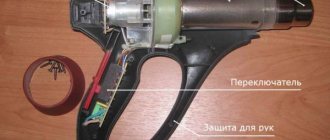Every person who has used a circular saw at least once knows how difficult it is to make an even cut. To somehow simplify this task, some use a special guide. This design will help you make perfectly straight cuts. Create a guide for a circular saw with your own hands.
A circular saw is often used in the household for cutting wood.
Guide bar - what is it?
Before you create such a design yourself, you need to familiarize yourself with its main features.
A guide bar is a special rail that is responsible for sliding the saw forward and backward. At the same time, it limits the movement of the tool and therefore it cannot be directed to the left or right.
This device is used not only to ensure an even cut. It also helps reduce the number of chips in places where the saw came into contact with the wood being cut.
Additional Information! Sometimes guides are included with circular saws from Bosch and Interskol.
Creating legs
Assembling a full-fledged device for a circular saw is not limited to these stages.
For the legs you will need a board 5 x 10 cm. Their height is 1-1.2 m.
The board is cut along the longitudinal vector. In this case, a slight angle is maintained on one side.
The legs are fitted to the tabletop. During installation they should be slightly apart.
They are attached outside the stiffeners. Fastening method: bolted. To increase their stability, you will need ties. They require a 5 x 5 cm block.
The hand saw is placed in the previously created groove from the lower area of the tabletop. The sole is fixed with bolts. The disc is placed in the slot.
The table is varnished in 3-4 layers. This is a measure against moisture.
Guide rail functions
There are several main functions that these structures perform:
- increased accuracy when sawing large materials;
- improved quality when creating a curved cut;
- simplifying the creation of parts in accordance with a certain standard;
- the ability to manufacture several parts using one template;
- increasing safety when using circular saws.
Also, with the help of guides, it will be possible to make cuttings with high accuracy.
Machine
A machine for sharpening circular saws is not just one device. This can be called a large group of equipment and tools for special purposes.
– Automatic. The sharpening process is completely mechanized and there is no need for human participation. Such devices are used for production purposes.
- Manual. These can be any devices and tools for sharpening by hand. The productivity of such equipment is much lower than automatic machines. This type has found application in handicraft workshops for domestic needs.
Equipment of this kind is available for sale in a wide range; devices may differ in function, power and price. A manual machine for sharpening circular saws, the price of which will be much lower (about 20 thousand rubles), can be made independently. The equipment consists of dense and hard alloy plates that serve as cutters.
Plates for them are made from alloys of various compositions.
Advantages of a homemade guide bar
The guide allows you to make straight cuts.
Many people think that homemade splints have no advantages. However, in fact they have a number of advantages:
- ease of use;
- repeated use;
- durability;
- versatility.
Homemade designs also have their drawbacks. The main disadvantage is that they are not easy to make. Therefore, to avoid problems, you need to figure out in advance how to make guides for a circular saw with your own hands.
artisanal
Sharpening it yourself won’t be too difficult. Especially if you have the necessary equipment. And if not, then you can make it yourself. You can make a machine for sharpening circular saws, the price of which will only please you, from simple parts. To do this you will need the following basic elements:
The circle is fixed on the engine, the disk blade is on the caliper, the screws will ensure the movement of the workpiece along the axis of the circle, which will provide the desired angle.
The main task for such an element as a machine for sharpening circular saws is to fix them in the required position relative to the circle. This is necessary to accurately maintain the angles; this can be provided by a stand mounted on the machine frame in the same plane as the circle.
When placing the disk on a stand, the teeth must be perpendicular to the plane of the sawing machine.
Required materials and tools
Before you begin manufacturing the structure, you need to familiarize yourself with the list of necessary tools and materials:
- wooden blanks: boards, plywood, laminate;
- wooden bars with a thickness of 10 cm;
- self-tapping screws, screws, bolts or nuts;
- drill with drills;
- screwdrivers or screwdriver.
Additional Information! The above tools must be prepared in advance so that they are at hand while creating the guide.
Sharpening angles
The fundamental angles are those determined by the shape of the teeth. These are front and rear, as well as bevel along the front and rear planes.
For longitudinal cutting of the front angle, it is recommended to set the degree in the range from 15 to 25. For transverse cutting - 5-10 degrees. For universal saws of both sections, it is more correct to choose the average value of 15 degrees.
The size of the angle is also determined by the hardness of the cutting material.
You can buy a machine for sharpening carbide circular saws at a cost of 15,000 rubles. You can also shell out for more expensive devices. For example, PP-480Z will cost its owner 280,000 rubles. Prices vary and depend on the purpose of the device, its functions, power and performance. For a small workshop or home use, you can purchase a JMY8-70 circular saw sharpening machine. Its cost is within 18,000 rubles.
Detailed instructions for manufacturing
To make a circular tire yourself, you need to familiarize yourself with the basic rules for its manufacture in advance.
From plywood
Plywood is often used to create a tire.
The plywood structure is made in several sequential steps:
- Disconnect the circular saw from the power source.
- Measure the distance from the saw blade to the groove located on the support platform.
- Cut the plywood strip so that its width is a millimeter less than the distance obtained in the previous step.
- Fasten the strip to a wide piece of plywood.
- Attach the second strip parallel to the base of the instrument.
Important! Before you make a guide yourself, you need to create a drawing with accurate calculations.
Aluminum profile tire
Some people want to make a more durable and high-quality structure. For this they use an aluminum profile. The only serious difference between such products and plywood is that a U-shaped aluminum profile is installed in the guide gap. With its help, it is possible to significantly increase the rigidity of the entire structure. Thanks to this, the cutting accuracy also increases.
When creating aluminum busbars, thick plywood is often used as restraints. However, it is better to install several fluoroplastic plates instead. This material is more efficient because it has a low coefficient of friction.
Other varieties
The construction rule is often used as a guide.
You can make a guide bar for a circular saw with your own hands from a miter box rail. Most often, this device is used for cross-sectioning materials. It consists of two corners that are connected in parallel to each other. Their ends must be attached to an iron or plywood base.
If the rail miter box will be used in a circular saw, it must be attached using metal pins or bolts. The structure must be installed higher so that it does not come into contact with the work surface.
Additional Information! Some people use a ruler from the building code as a guide bar. However, this design is not very convenient, since it must be configured before each use.
Types of reciprocating saw blades
The cutting tool of a reciprocating saw is a blade, which is a plate made of special high-strength alloys, which has cutting teeth on one side. Using different types of blades, you can make cuts without nicks and burrs with maximum accuracy.
According to the shape of the teeth
The cleanliness of the cut and the cutting speed depend on the shape and size of the blade teeth. Also, a special form of cutters has been developed for processing certain types of materials. So, reciprocating saw blades can have the following tooth shapes.
- M-shaped teeth. The blade has milled cutters, allowing you to cut material both forward and backward. The equipment is used for cutting ferrous and non-ferrous metals, stainless steel, wood, especially if it contains metal particles, as well as various types of plastics.
- Sharp, milled, variable pitch teeth. The blade has set cutters and is used for direct cutting of any type of wood, including those with metal particles.
- Milled cutters with wavy layout. The equipment is used for cutting metal up to 2.5 mm and any type of wood with metal inclusions.
- M-shaped, inclined, with variable pitch. This is a universal and high-performance tool with set teeth. Designed for cutting all types of wood with metal inclusions and for cutting metal up to 2.5 mm.
- Small, milled, set incisors. The blade is used for direct cutting of metal products with a thickness of no more than 1.5 mm.
In addition, the canvases differ in the material from which they are made, as evidenced by the markings applied to any type of equipment.
Marking of canvases
Reciprocating saw blades are made from the following materials.
- HCS. This marking indicates that the base of the tool is high-carbon steel. Saws are designed for cutting wood and wood-based products, as well as plastic and rubber.
- HSS is a tool high-speed steel. With its help you can work on non-ferrous metals, as well as cut sheet and profile metal.
- BIM is a bimetallic alloy that is a combination of the strong and flexible HSS and HCS steels. These blades have a long service life and are used for cutting aerated concrete, as well as sawing boards with nails.
- HM/CT is carbide tooling. Saws are used for cutting porous and abrasive materials: structures made of concrete, fiberglass and fiberglass, aerated concrete and tiles.
- CV is a chromium vanadium alloy. Equipment made from it is characterized by increased wear resistance and is used for work on plastic and wood of any species.
Criterias of choice
When choosing a blade for a saber-type unit, you must first of all pay attention to the shank of the equipment. Blade mounts can be either universal, suitable for most models of units, or intended only for one brand of reciprocating saws.
The size of the teeth is also important. Large teeth provide high cutting speed, but cannot provide good quality cuts. Therefore, to obtain a neat cut, equipment with fine teeth is used.
The blade cutters of saber-type devices can be ground or milled. Equipment with ground cutters is used for cutting soft materials. To cope with metal or hardwood, saws with milled cutters are used.
Blades with set teeth are characterized by high productivity, and equipment with wavy cutters processes the part more efficiently.
Additional guide bar functions
Using a guide bar, it is extremely difficult to damage the material being cut.
Such designs have a number of additional functions that you should familiarize yourself with before using a homemade guide bar for a hand-held circular saw:
- protects the sawn material from damage;
- allows you to adjust the exact length of the cut;
- significantly speeds up the process of sawing wood;
- securely fixes the wood to the work surface.
Additional Information! Both branded guides and homemade designs can boast of the above additional functions.
About the elements of the frame
The attachments for a circular saw are different. The main one is the bed. If the power of the saw is insignificant (no more than 1.2 kW), such a frame is not difficult to build yourself. Its length is affected by the length of the material going for cutting.
A Bosch electric drill is suitable for the drive; its parameter is 0.85 kW. It is mounted under the stove using a special bracket.
The accuracy and evenness of the cut is better when the workpiece rests entirely on the table surface. And if the table has too large parameters, it will fill the entire work area. Here you need an average value. The height is selected according to your height to make it more convenient to work.
How to adjust correctly
Before you start working, you need to properly adjust the structure. You will have to independently choose the optimal location and point for further fixation.
It is necessary to position the device so that its edge lies flat against the cut line and without distortion. After this, you need to adjust the placement of the saw blade. It must be torn off from the casing and aligned perpendicularly to the cutting line.
When the disk and guides are adjusted, the structure is fixed with clamps. This is done to minimize vibrations that may occur while the saw is running.
Important! To cut wood at an angle of 45 degrees, you will need to adjust the saw blade or adjust the angle on the bar itself. This must be done very carefully to avoid mistakes when adjusting the tilt.
Sharpening question
The circular saw needs to be sharpened when the following symptoms appear:
- It becomes harder to work with her.
- It leaves black marks on the material.
- There is a nasty smell and smoke.
Ideally, it should be sharpened on a professional machine. If you don't have one, you'll need a tool for sharpening circular saws.
Required set for work:
- Vise.
- File with flat functional side.
- Beam.
You should work with gloves.
Sharpening stages:
- Rigid fixation of the disc. It is removed from the saw and secured in a vice. In this case, wooden dies are used. You can leave it in the saw, but stick a block between its teeth. The block rests on some surface.
- The initial tooth is marked.
- The back of the tooth is processed with a file. They need to swipe it several times. The effort is small. Each tooth is sharpened in turn. The movements are uniform, the number of strokes with the file is the same.
- The front parts of the teeth are processed. The principle is the same.
The tips of the teeth should be perpendicular to the surface of the disc.
All teeth are then inspected for defects. The edges should not be shiny. If so, they are smoothly filed with a file.
After this, the disk is checked in action. It fits into the saw. It turns on. A test block is used. If the saw is light, smooth and quiet, then the sharpening is of high quality.
Otherwise, you need to check the height of the teeth. To align them, you need to bring the marker to the working edge. Then the disk must go through the entire revolution in the other direction from the rotation. A mark remains on all teeth. You can use it to adjust their height. The highest teeth are carefully processed with a file.
Useful tips
Blank templates make the work much easier.
There are several useful recommendations that will help beginners use a circular saw with a guide:
- It is necessary to use special blank templates. With their help you can quickly make identical parts.
- Before starting work, you need to adjust and configure everything in advance. Only with a properly configured tool will it be possible to cut wood efficiently.
- Do not work at the circular saw for too long. The tool must be turned off periodically to prevent it from overheating.
- The tire must be securely attached. It must not slide on the work surface. Bolts or screws can be used as fastenings.
- If, during sawing, the circular saw begins to sharply slow down, it must be turned off. This often happens when a tool works continuously for a long time and begins to overheat.
Important! If you need to cut an even cut, you must use a guide. Without it, it is quite difficult to do this.
A circular saw is an indispensable tool that allows you to quickly cut wood products. People who want to do quality work should use special guides. Such designs can be purchased or made independently.
Carriage for Chainsaw for Longitudinal Sawing with Your Hands
Boards are intensively used for various construction and repair activities. There is an option to make such material independently from any suitable log using an ordinary chainsaw.
A chainsaw, often also called a chainsaw, is essentially a chain hand tool equipped with a two-stroke (almost always) gasoline engine. This popular mechanism is indispensable in any homestead. The chainsaw is small-sized and at the same time powerful. It works without breakdowns for a long time in offline mode, so it can be used in any location and in a position that is comfortable for the user. A chainsaw also has the following advantages:
- Equipped with mechanisms for selecting operating speed and soft start. Therefore, the risk of breaking the chain is reduced to zero.
- Used when wet.
- Does not require electronic energy.
- It is characterized by the highest power indicators (tangibly greater than that of a power tool).
- Has a quick-acting inertia brake.
A chainsaw is essentially a chain hand tool
The main advantage of a gasoline saw is the ability to equip it with different attachments. It is they who make it a universal tool, irreplaceable for the home craftsman. Using a chainsaw, you can saw logs, cut stone, metal, brick, tiled building materials, remove bark from wood, cut out mounting grooves and various recesses in bars.
The functionality of the tool can be expanded to a greater extent; the main thing is to choose the right attachment or equip it with a special device.
We will not outline what remains to be done for our client with the ability of a chainsaw. For the purposes of this article, we are only interested in the issue of sawing logs using a chainsaw. More on the specifics of doing such work on your own.
Cutting a log with a gasoline saw can be done after equipping it with various types of devices and special attachments. It is not difficult to obtain relatively even boards from the trunk of an old, withered tree on your own summer cottage if you install a standard attachment for longitudinal cutting of wood on your chainsaw. Fundamental point. You will not get perfect boards using this attachment. But the cut products can be used to build a fence around the site or a simple shed.


